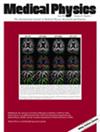Design optimization of a 1-D array of stemless plastic scintillation detectors
Abstract
Background
A stemless plastic scintillation detector (SPSD) is composed of an organic plastic scintillator coupled to an organic photodiode. Previous research has shown that SPSDs are ideally suited to challenging dosimetry measurements such as output factors and profiles in small fields. Lacking from the current literature is a systematic effort to optimize the performance of the photodiode component of the detector. An optimized detector could permit a reduction in detector element size, thus improving spatial resolution without degradation of the signal to noise ratio values seen previously.
Purpose
SPSDs use an organic photodiode coupled to a plastic scintillator to measure ionizing radiation fields. The design retains the benefits of plastic scintillation detectors (energy and dose rate independence, no perturbation factors, etc.) but avoids the challenges of optical fiber-based systems (Cerenkov radiation). In this work, the design of a 1-dimensional array of SPSDs is optimized to maximize the measured signal.
Methods
ITO-covered PET was etched using hydrochloric acid, and the substrate was cleaned. PEDOT: PSS and P3HT: PCBM (different weight ratios) were then applied to the substrate using spin-coating. Finally, aluminum top electrodes were added using vacuum thermal evaporation to complete the fabrication process. The variables studied for the optimization included: spin coater's speed (i.e., film thickness), P3HT: PCBM ratio, solution concentration, and scintillator coating.
Results
Increasing the film thickness from ∼80 nm to ∼138 nm increased the measured signal by a factor of approximately 7.7. Changing the ratio of P3HT to PCBM from (1:1) to (4:1) resulted in approximately 3.5 times higher signal. Additionally, increasing the total concentration of the solution from 2% to 4% by weight ratio increased the signal by roughly a factor of 2.5 for a P3HT: PCBM ratio of 2:1. However, for a P3HT: PCBM ratio of 4:1, increased solution concentration reduced measured signals to approximately 1.7 times lower than normal concentration. Covering the air gaps of the etched scintillator with white paint resulted in a signal increase of about 2.2 times higher compared to black paint.
Conclusion
An optimization process was conducted to improve the signal output of the radiation detector, which consisted of a 1-dimensional photodiode array combined with a scintillator. This approach has resulted in a sensitivity increase of about 24 times compared to the original sample prior to optimizing the fabrication parameters and scintillator's properties (∼0.02 nC/cGy vs. ∼0.5 nC/cGy). The most efficient device was found to have a weight ratio of (2:1) P3HT: PCBM and a total solution concentration of 4%. Additionally, using a scintillator painted white was found to produce superior outcomes compared to black paint.

 求助内容:
求助内容: 应助结果提醒方式:
应助结果提醒方式:


